Abstract
Methyl benzoate (MB) compounds are prepared by reacting various benzoic acids with methanol using an acidic catalyst. In this study, the solid acids of zirconium metal solids fixed with various substances were studied. We determined that zirconium metal catalysts with fixed Ti had the best activity. The catalytic synthesis of a series of MB compounds using titanium zirconium solid acids was studied. The direct condensation of benzoic acid and methanol using a metallic Lewis acid without other auxiliary Bronsted acids is reported for the first time.
1. Introduction
Methyl benzoate (MB) compounds are an important class of chemical products. Most of these compounds have low toxicity and are mainly used in scents and as solvents [1,2,3,4,5,6,7,8,9,10,11,12,13,14]. For example, MB has a fruity flavor that can be used in pineapple, strawberry, and cherry syrups, and it as acts as a solvent in resin rubber. Additionally, p-methoxybenzoic acid is also used as a flavoring, and methyl p-bromobenzoate is the main raw material of pemetrexed disodium, an antitumor drug, and diglitin A [15], an antifungal compound [16,17,18].
The synthesis of MB is catalyzed by various inorganic and organic acids, such as sulfuric, phosphoric, and p-toluenesulfonic acid [19,20,21,22,23,24,25]. However, these acids are not recoverable, and a large amount of water is required to clean them; therefore, a large amount of wastewater is produced during this process, polluting the environment. Sulfuric acid is often used in industry because of its low price; however, the yield of sulfuric acid is not high because of its oxidation. Solid acids are now being developed for use in ester synthesis reactions as an alternative to common acids [6,26].
Solid acids are both strongly acidic and insoluble in organic solvents [26,27]. Therefore, solid acids are recoverable and can be used multiple times. Herein, we present our synthesis of a series of reusable supported solid acids for use in the synthesis of MB compounds. Beena Tyagi’s research group reported the use of zirconate sulfate as a catalyst for methyl palmitate [28,29]. A zirconia-based phyto-nanocatalyst was used to catalyze novel non-edible Bischofia javanica seed oil into methyl ester [30]. In this study, zirconium with various carriers was used as a catalyst in the synthesis of methyl benzoates. Pure zirconium compounds are solids, such as zirconia, which can be used in the form of solid spheres [30]. The addition of a carrier leads to zirconium forming a cage structure more conducive to catalysis.
Zirconium solid acid was synthesized using catalysts with different supports, and the catalyst with the highest activity was selected. This catalyst catalyzed the esterification of methanol and benzoic acid with different functional groups. The catalytic formation of methyl benzoate using Lewis Al2O3 has been reported, requiring the auxiliary catalyst MeSO3H [31]. The catalytic generation of methyl benzoate with Lewis Fe2(SO4)3·xH2O has been reported. The auxiliary catalyst concentrated H2SO4 is needed [32]. The use of metal Lewis as a catalyst for the synthesis of MB without adding other acids has not been reported.
2. Results
2.1. Characteristics of the Catalyst
Zirconium solid acid and its carriers were synthesized in a one-to-one atomic molar ratio. These zirconium solid acids were synthesized from various raw materials (Table 1). In order for these atoms to mix well, the raw materials used must be completely liquid. The ingredients chosen are either inherently liquid or very soluble in water. The selection of raw materials is shown in Table 1. The solid form of the raw material was mixed into a certain concentration of water solution before use.

Table 1.
Various raw materials for zirconium solid acids.
2.1.1. XRD
Figure 1 shows the X-ray diffraction (XRD) patterns of the solid acids (Table 1). The XRD curves indicate that the catalysts had a large number of amorphous phases and show obvious amorphous diffraction peaks (steamed bun peaks) in the range of 2θ = 10°–40°. Zinc oxide [33] and titanium oxide [34] have been reported to have good crystal forms. The prepared catalysts had poor crystal forms.
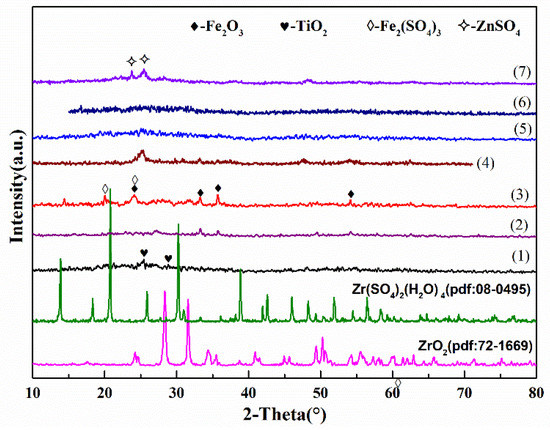
Figure 1.
XRD curves of the catalysts in Table 1.
2.1.2. FT-IR
Above is the infrared spectrum of Zr/Ti (entry 10, Table 2, abbreviated as ZT10). The infrared multiplet absorption peak at 1040–1180 cm−1 (Figure 2) was attributed to the S=O double bond. It was observed that the [SO4]2− was bonded to the catalyst. The peak at 1400 cm−1 was attributed to the vibrational absorption of the covalent S=O double bond, which is the characteristic absorption of a solid superacid. This finding indicates the successful synthesis of the solid superacid. The other absorption peaks belonging to the solid catalysts are not detailed.

Table 2.
Synthesis of methyl p-toluenate and methyl p-chlorobenzoate using different catalysts a,b.
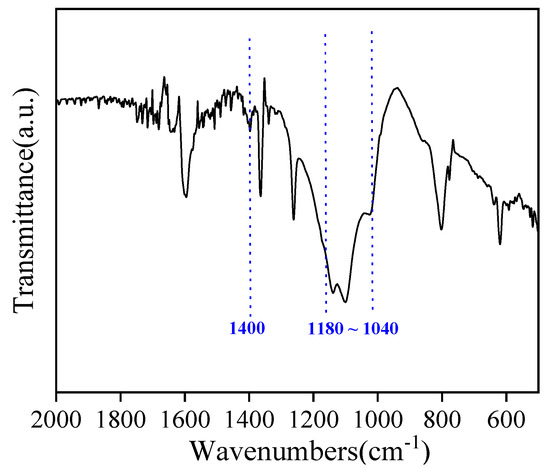
Figure 2.
FT−IR spectra of ZT10.
2.1.3. SEM
The following are the SEM pictures. Diagram A shows a 1 μm electron microscopy of ZT10. B shows a 5 μm electron microscopic image of ZT10. C presents an electron microscopy of Zr (entry 4, Table 2, abbreviated as Zr0) at 1 μm (Figure 3). D shows a 5 μm electron microscope image of Zr0. Titanium metal was used as a carrier to form a honeycomb solid of zirconium metal. In the catalytic process, methyl alcohol and benzoic acid can enter the honeycomb to react, effectively improving the catalytic activity.
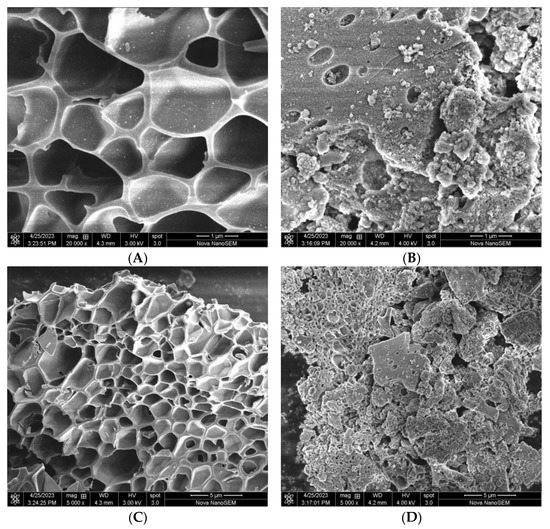
Figure 3.
SEM images: (A) (ZT10, 1 μm), (B) (Zr0, 1 μm), (C) (ZT10, 5 μm), (D) (Zr0, 5 μm).
2.1.4. EDS
It can be seen from Figure 4 that the surface of ZT10 contained C, Ti, O, Zr, S, etc. The content of Zr was particularly high, which indicates that zirconium plays a major role in the synthesized catalyst. Sulfur, oxygen, and metals were partly in the form of sulfate.
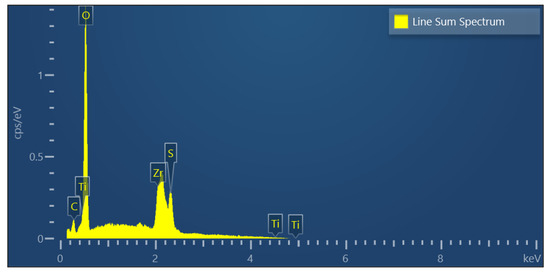
Figure 4.
EDS image of ZT10.
Figure 5 below shows the TGA of catalyst ZT10. The results show that there was a significant weightlessness at 84.32 °C. This was due to the evaporation of free water on the surface of the sample. The main weight loss temperature was 735.28 °C. At this temperature C, S, and O atoms were recombined to form small molecules such as CO2, CO, SO2, etc. The evaporation of these small molecules was the reason for the mass loss.
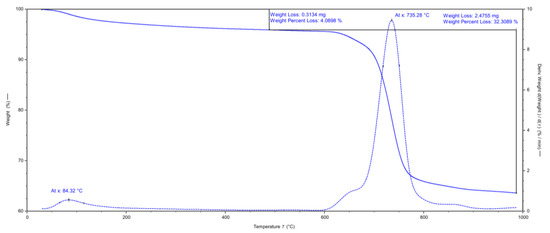
Figure 5.
TGA of ZT10.
2.2. Comparison of Catalyst Activity
These solid acids catalyzed reactions of methanol with p-chlorobenzoic acid and p-methylbenzoic acid. Titanium, as a supporting compound, exhibited the highest catalytic activity among the solid acids. The catalytic activities of zirconium and titanium mixtures with different atomic molar ratios were observed. The zirconium-titanium atomic molar ratio of 1.2 exhibited the highest catalytic activity. Zirconium alone was found to have a poor catalytic effect. The honeycomb structure of ZT10 results in higher catalytic activity. Zinc-zif-7 (CAS:909531-29-9) with a three-dimensional network structure was used to catalyze the reaction between benzoic acid and methyl ester (under the same conditions as in Table 2) with a yield of only 34.1%. This may be due to the fact that the central metal zinc atom is less acidic than zirconium.
The mechanism of esterification may be ZT10 binding with carboxylate. Fast dissociation of hydrogen ions was observed. The hydrogen ion activated the carbonyl group. Methanol electrophiles formed the carbonyl group. The water molecules were removed to form methyl benzoate.
2.3. Properties and Activity of Preferred Catalyst
The strength of ZT10 was determined using the Hammett method. The solid acid could significantly change the color of 2,4-dinitrotoluene (H0 = −13.75) and 2,4-dinitrofluorobenzene (H0 = −14.52) but not that of 1,3,5-trinitrobenzene (H0 = −16.02). The catalyst was an acid with an acid strength range of −16.02 < H0 < −14.52. This indicates that the solid acid was a solid superacid.
A series of catalytic studies were carried out using the preferred solid acid with a Zr–Ti atomic ratio of 1.2:1. The catalytic results are summarized in Table 3. The yields of the compounds (1, 4, 7, 10, 13) indicate that the presence of a large group in the ortho position decreased the yield. Orthosteric effects play a dominant role in the esterification process. However, the steric hindrance effect at the para-position was small (16, 17, 18). Therefore, MB with strong electron-absorbing groups on the benzene ring was obtained in a low yield. For example, the yield of MB with a nitro group in the ortho position was only 20.1%, and the compound with a trifluoromethyl group in the ortho position was obtained with only 29.1% yield. This is because of high steric hindrance and strong electron absorption effects, which make esterification difficult. For the same functional group, the para-substituted product yields were higher than those of the relative and intermediate sites, regardless of whether it was an electron-withdrawing or electron-donating group (e.g., 1, 2, 3; 4, 5, 6; 19, 20, 21). In the case of the benzene ring with two carboxyl groups, the reaction activity was low because of the large steric hindrance and strong electric absorption of the carboxyl group. The two carboxyl groups each underwent esterification, and moderate yields were also obtained for 31, which had a large steric hindrance from three methoxy groups, and 32, which had a perfluorinated substitution.

Table 3.
Synthesis of methyl benzoate with substituents a,b.
As previously reported, direct metal–Lewis acid interaction has not been found to catalyze the reaction of direct benzoic acid and methanol to form methyl benzoate. Dehydration esterification is a reversible reaction. It requires high energy and the removal of the resulting water molecules to move the reaction forward. In the catalytic process, methanol is strongly reflux. Methanol can be supplemented when the amount of methanol is too low. The methanol that does not condense will remove the water and move the reaction forward.
2.4. Properties and Activity of Recovered Catalyst
Because the esterification reaction is heterogeneous, the catalyst and reactants can be directly separated via solid–liquid separation after the initial reaction. After the reaction liquid was filtered and discarded, new reactants were added. The activity of the second reaction was similar to that of the first. Taking compound 7 as an example, the catalyst afforded an 84.1% yield in the second reaction.
Nitrogen adsorption of the recovered and original catalysts was also studied. The specific surface area of the catalyst was 242 m2/g, and the pore size was approximately 2 nm. The recovered and primary catalysts exhibited comparable pore structures and specific surface areas (Table 4).

Table 4.
Surface properties of the catalyst and the regenerated one.
3. Materials and Methods
3.1. Synthesis of the Catalyst
Dichlorooxyzirconium, cadmium chloride, aluminum chloride, tetraethoxysilane iron chloride, zinc chloride, tetrabutyl titanate, and methanol were purchased from Sinopharm Chemical Reagent Co., Ltd. (Shanghai, China) Benzoic acid and other benzene compounds were purchased from Aladdin Reagent Co., Ltd. (Shanghai, China) Deionized water (18.2 MΩ·cm) was used in the catalyst synthesis. All materials were used as received. 1H, 19F, and 13C NMR spectra (Figures S1–S32) were measured on a Bruker AVANCE (400 MHz, Bruker, Billerica, MA, USA) spectrometer using TMS as the internal standard and CDCl3 as a solvent.
The zirconium catalyst was synthesized with cadmium as a carrier. Zirconium oxychloride was prepared as a 50% aqueous solution. Cadmium chloride was prepared as 30% aqueous solutions. The ratio of the solutions was calculated according to the molar ratio, and quantitative zirconium oxychloride and aqueous chloride solutions were mixed by weight. The mixture was placed in an oven at 100 °C until it reached a constant weight. The dried mixture was added to a 2 mol/L sulfuric acid solution and soaked for 24 h. After soaking, the products were dried in the oven at 120 °C until the weight was constant. The mixture was bagged and heated in a Muffle furnace at 550 °C for 12 h.
The zirconium catalyst was synthesized with cadmium as a carrier. Zirconium oxychloride was prepared as a 50% aqueous solution. Zinc chloride was prepared as 50% aqueous solutions. The ratio of the solutions was calculated according to the molar ratio, and quantitative zirconium oxychloride and aqueous chloride solutions were mixed by weight. The mixture was placed in an oven at 100 °C until it reached a constant weight. The dried mixture was added to a 2 mol/L sulfuric acid solution and soaked for 24 h. After soaking, the products were dried in the oven at 120 °C until the weight was constant. The mixture was bagged and heated in a Muffle furnace at 550 °C for 12 h.
The zirconium catalyst was synthesized with aluminum as a carrier. Zirconium oxychloride was prepared as a 50% aqueous solution. Aluminum chloride was prepared as 60% aqueous solutions. The ratio of the solutions was calculated according to the molar ratio, and quantitative zirconium oxychloride and aqueous chloride solutions were mixed by weight. The mixture was placed in an oven at 100 °C until it reached a constant weight. The dried mixture was added to a 2 mol/L sulfuric acid solution and soaked for 24 h. After soaking, the products were dried in the oven at 120 °C until the weight was constant. The mixture was bagged and heated in a Muffle furnace at 550 °C for 12 h.
A zirconium oxychloride solution was prepared using silicon as the support catalyst at 50 wt% based on the molar ratio. After rapid stirring, proportional ethyl orthosilicate was added. The mixture was stirred and placed in the oven at 100 °C until the weight was constant. The dried mixture was added to a 2 mol/L sulfuric acid solution and soaked for 24 h. The mixed solution was placed in the oven at 120 °C until the weight was constant. The mixture was bagged and heated in a Muffle furnace at 550 °C for 12 h.
A zirconium oxychloride solution was prepared using titanium as the support catalyst at 50 wt% based on the molar ratio. A proportional amount of tetrabutyl titanate was added after rapid stirring. After thorough mixing, it was placed in the oven to bake at 100 °C until the weight was constant. The dried mixture was added to a 2 mol/L sulfuric acid solution and soaked for 24 h. The mixed solution was placed in the oven at 120 °C until the weight was constant. The mixture was bagged and heated in a Muffle furnace at 550 °C for 12 h.
3.2. General Catalytic Process
Taking p-methylbenzoic acid as an example, 0.27 g of (2 mmol) p-methylbenzoic acid, 15.00 mL of methanol, and 0.027 g of catalyst were added into a 25 mL single-mouth flask successively and vigorously stirred. In an oil bath at 120 °C, the mixture was strongly refluxed. If there is too little methanol during reflux, a small amount can be added. The reaction was stopped after 24 h, and the catalyst was removed. The product was isolated using column chromatography with petroleum ether/ethyl acetate (5:1 v/v) as the mobile phase.
3.3. Recovery Catalyst Catalytic Process
The reaction was completed and the reaction liquid was poured out. A small amount of residual solid from methanol washing was used as a catalyst. Additionally, 0.27 g of (2 mmol) p-methylbenzoic acid and 15.00 mL of methanol were then added into a 25 mL single-mouth flask with the used catalyst and vigorously stirred. In an oil bath at 120 °C, the mixture was strongly refluxed. If there was too little methanol during reflux, a small amount was added. The reaction was stopped after 24 h, and the catalyst was removed. The product was isolated using column chromatography with petroleum ether/ethyl acetate (5:1 v/v) as the mobile phase.
After the catalyst was recovered, it was baked at 100 °C until a constant weight was reached for nitrogen adsorption.
4. Conclusions
Zirconium solid acid catalysts, supported by various compounds, have been synthesized, and their catalytic activities for synthesizing MB compounds were studied. The experimental results show that titanium was the best carrier for zirconium. The catalyst (ZT10) prepared with a Zr: Ti molar ratio of 1.2:1 exhibited the best catalytic effect.
ZT10 catalyzed the synthesis of MB from benzoic acid with a substituted group and methanol. The experimental results demonstrate that this catalyst could catalyze the reactions of benzoic acid and methanol, regardless of whether the benzene ring of benzoic acid contains electron-donating groups, strong electron-absorbing groups, small steric hindrance groups, or large steric hindrance groups. We also demonstrated that the catalyst could be easily separated from a reaction mixture and reused with no impact on its performance.
Supplementary Materials
The following supporting information can be downloaded at: https://www.mdpi.com/article/10.3390/catal13050915/s1; Figure S1: 1H and 13C NMR of methyl 2-methylbenzoate; Figure S2: 1H and 13C NMR of methyl 3-methylbenzoate; Figure S3: 1H and 13C NMR of methyl 4-methylbenzoate; Figure S4: 1H, 13C and 19F NMR of methyl methyl 2-fluorobenzoate; Figure S5: 1H, 13C and 19F NMR of methyl methyl 3-fluorobenzoate; Figure S6: 1H, 13C and 19F NMR of methyl methyl 4-fluorobenzoate; Figure S7: 1H and 13C NMR of methyl 2-chlorobenzoate; Figure S8: 1H and 13C NMR of methyl 3-chlorobenzoate; Figure S9: 1H and 13C NMR of methyl 4-chlorobenzoate; Figure S10: 1H and 13C NMR of methyl 2-bromobenzoate; Figure S11: 1H and 13C NMR of methyl 3-bromobenzoate; Figure S12: 1H and 13C NMR of methyl 4-bromobenzoate; Figure S13: 1H and 13C NMR of methyl 2-iodobenzoate; Figure S14: 1H and 13C NMR of methyl 3-iodobenzoate; Figure S15: 1H and 13C NMR of methyl 4-iodobenzoate; Figure S16: 1H and 13C NMR of methyl benzoate; Figure S17: 1H and 13C NMR of methyl 4-Tert-Butylbenzoate; Figure S18: 1H and 13C NMR of methyl 4-cyanobenzoate; Figure S19: 1H and 13C NMR of Methyl 2-nitrobenzoate; Figure S20: 1H and 13C NMR of Methyl 3-nitrobenzoate; Figure S21: 1H and 13C NMR of Methyl 4-nitrobenzoate; Figure S22: 1H and 13C NMR of Methyl 2-methoxybenzoate; Figure S23: 1H and 13C NMR of Methyl 3-methoxybenzoate; Figure S24: 1H and 13C NMR of Methyl 4-methoxybenzoate; Figure S25: 1H, 13C and 19F NMR of Methyl 2-trifluoromethylbenzoate; Figure S26: 1H, 13C and 19F NMR of Methyl 3-trifluoromethylbenzoate; Figure S27: 1H, 13C and 19F NMR of Methyl 4-trifluoromethylbenzoate; Figure S28: 1H and 13C NMR of o-Dimethyl phthalate; Figure S29: 1H and 13C NMR of m-Dimethyl terephthalate; Figure S30: 1H and 13C NMR of p-Dimethyl terephthalate; Figure S31: 1H and 13C NMR of methyl 3,4,5-trimethoxybenzoate; Figure S32: 1H, 13C and 19F NMR of Methyl 2,3,4,5,6-pentafluorobenzoate. References [35,36,37,38,39,40,41] are cited in the Supplementary Materials.
Author Contributions
Conceptualization, writing—original draft preparation, X.Y. and C.S.; methodology, S.H.; formal analysis, Y.C. and Y.Z.; writing—review and editing, R.S. All authors have read and agreed to the published version of the manuscript.
Funding
This research was funded by the Natural Science Foundation of Anhui Provincial Natural Science Foundation of China (2008085ME174), Higher Education Institutions of Anhui Province (KJ2019A0856), and the Bengbu University-funded project of scientific research startups for high-level talents (BBXY2018KYQD20).
Conflicts of Interest
The authors declare no conflict of interest.
References
- Kapoor, D.; Bhardwaj, S.; Sharma, N.R. Fragrance Stimulation Mechanisms of Flowers and their Regulation under Environmental Constraints. J. Plant Growth Regul. 2023, 42, 60–82. [Google Scholar] [CrossRef]
- Tian, Y.-F.; Chen, Y.-X.; Tong, X.; Hou, S.; Zhao, M.-M.; Feng, Y.-Z. Flavor differences of soybean and defatted soybean fermented soy sauce and its correlation with the enzyme profiles of the kojis. J. Sci. Food Agric. 2023, 103, 606–615. [Google Scholar] [CrossRef]
- El Mansouri, A.-E.; Lachhab, S.; Oubella, A.; Mehdi, A.; Neyts, J.; Jochmans, D.; Chiu, W.; Vangeel, L.; De Jonghe, S.; Morjani, H.; et al. Synthesis, characterization, molecular docking, and anticancer activities of new 1,3,4-oxadiazole-5-fluorocytosine hybrid derivatives. J. Mol. Struct. 2023, 1272, 134135. [Google Scholar] [CrossRef] [PubMed]
- Ning, S.; Zheng, L.; Gao, Q.; Shi, L.; Liu, Y.; Sun, C.; Zhang, Z.; Xiang, J. New electrotriggers: P-methoxycarbonylbenzyl (pMCB) as an electroremovable protecting group for carboxylic acids, phosphoric acids and alcohols. Green Chem. 2022, 24, 5632–5636. [Google Scholar] [CrossRef]
- Li, J.-G.; Peng, Y.-Q. Efficient Methyl Esterification Using Methoxyl Silica Gel as a Novel Dehydrating Reagent. J. Chin. Chem. Soc. 2010, 57, 305–308. [Google Scholar] [CrossRef]
- Travis, B.R.; Sivakumar, M.; Hollist, G.O.; Borhan, B. Facile Oxidation of Aldehydes to Acids and Esters with Oxone. Org. Lett. 2003, 5, 1031–1034. [Google Scholar] [CrossRef]
- Talukdar, D.; Sharma, K.; Bharadwaj, S.K.; Thakur, A.J. VO (acac)2: An Efficient Catalyst for the Oxidation of Aldehydes to the Corresponding Acids in the Presence of Aqueous H2O2. Synlett 2013, 24, 963–966. [Google Scholar] [CrossRef]
- Han, J.; Gu, F.; Li, Y. N-Doped Sub-3 nm Co Nanoparticles as Highly Efficient and Durable Aerobic Oxidative Coupling Catalysts. Chem.-Asian J. 2016, 11, 2594–2601. [Google Scholar] [CrossRef]
- Lerebours, R.; Wolf, C. Chemoselective Nucleophilic Arylation and Single-Step Oxidative Esterification of Aldehydes Using Siloxanes and a Palladium−Phosphinous Acid as a Reaction Switch. J. Am. Chem. Soc. 2006, 128, 13052–13053. [Google Scholar] [CrossRef]
- Subramanian, K.; Yedage, S.L.; Bhanage, B.M. An Electrochemical Method for Carboxylic Ester Synthesis from N-Alkoxyamides. J. Org. Chem. 2017, 82, 10025–10032. [Google Scholar] [CrossRef] [PubMed]
- Liu, M.; Zhang, Z.; Yan, J.; Liu, S.; Liu, H.; Liu, Z.; Wang, W.; He, Z.; Han, B. Aerobic Oxidative Cleavage and Esterification of C(OH)–C Bonds. Chem 2020, 6, 3288–3296. [Google Scholar] [CrossRef]
- Mao, F.; Qi, Z.; Fan, H.; Sui, D.; Chen, R.; Huang, J. Heterogeneous cobalt catalysts for selective oxygenation of alcohols to aldehydes, esters and nitriles. RSC Adv. 2017, 7, 1498–1503. [Google Scholar] [CrossRef]
- Chng, L.L.; Yang, J.; Ying, J.Y. Efficient Synthesis of Amides and Esters from Alcohols under Aerobic Ambient Conditions Catalyzed by a Au/Mesoporous Al2O3 Nanocatalyst. ChemSusChem 2015, 8, 1916–1925. [Google Scholar] [CrossRef] [PubMed]
- Liu, C.; Wang, J.; Meng, L.; Deng, Y.; Li, Y.; Lei, A. Palladium-Catalyzed Aerobic Oxidative Direct Esterification of Alcohols. Angew. Chem. Int. Ed. 2011, 50, 5144–5148. [Google Scholar] [CrossRef]
- Wang, K.; Xu, Y.; Wang, J. Palladium-Catalyzed Cyclizative Borylation of Allenyl Ketones through Carbene Boryl Migratory Insertion: Access to Densely Substituted Furyl Boronates. Chem.-A Eur. J. 2023, 29, e2022036972023. [Google Scholar] [CrossRef]
- Xiao, Z.; Zhang, S.; Zhu, J.; Niu, Y.; Xiong, W.; Chen, F. Identification of key aromas of grapefruit juice and study of their contributions to the enhancement of sweetness perception. Eur. Food Res. Technol. 2023, 249, 537–551. [Google Scholar] [CrossRef]
- Chen, X.; He, Z.; He, L.; Li, C.; Tao, H.; Wang, X.; Liu, L.; Zeng, X.; Ran, G. Effects of perilla seed oil addition on the physicochemical properties, sensory, and volatile compounds of potato blueberry flavored yogurt and its shelf-life prediction. LWT 2023, 173, 114383. [Google Scholar] [CrossRef]
- Ji, G.; Liu, G.; Li, B.; Tan, H.; Zheng, R.; Sun, X.; He, F. Influence on the aroma substances and functional ingredients of apple juice by lactic acid bacteria fermentation. Food Biosci. 2023, 51, 102337. [Google Scholar] [CrossRef]
- Keana, J.F.W.; Cai, S.X. New reagents for photoaffinity labeling: Synthesis and photolysis of functionalized perfluorophenyl azides. J. Org. Chem. 1990, 55, 3640–3647. [Google Scholar] [CrossRef]
- De Oliveira, C.S.; Lira, B.F.; Dos Santos Falcão-Silva, V.; Siqueira-Junior, J.P.; Barbosa-Filho, J.M.; De Athayde-Filho, P.F. Synthesis, Molecular Properties Prediction, and Anti-staphylococcal Activity of N-Acylhydrazones and New 1,3,4-Oxadiazole Derivatives. Molecules 2012, 17, 5095–5107. [Google Scholar] [CrossRef] [PubMed]
- Štefane, B.; Kočevar, M.; Polanc, S. Ceric (IV) Ammonium nitrate mediated transesterification and esterification. Synth. Commun. 2002, 32, 1703–1707. [Google Scholar] [CrossRef]
- Martínez, R.; Zamudio, G.J.N.; Pretelin-Castillo, G.; Torres-Ochoa, R.O.; Medina-Franco, J.L.; Pinzón, C.I.E.; Miranda, M.S.; Hernández, E.; Alanís-Garza, B. Synthesis and antitubercular activity of new N-[5-(4-chlorophenyl)-1,3,4-oxadiazol-2-yl]-(nitroheteroaryl)carboxamides. Heterocycl. Commun. 2019, 25, 52–59. [Google Scholar] [CrossRef]
- Roy, S.; Samanta, D.; Kumar, P.; Maji, T.K. Pure white light emission and charge transfer in organogels of symmetrical and unsymmetrical π-chromophoric oligo-p-(phenyleneethynylene) bola-amphiphiles. Chem. Commun. 2018, 54, 275–278. [Google Scholar] [CrossRef] [PubMed]
- Stephens, M.D.; Yodsanit, N.; Melander, C. Potentiation of the fosmidomycin analogue FR 900098 with substituted 2-oxazolines against Francisella novicida. MedChemComm 2016, 7, 1952–1956. [Google Scholar] [CrossRef] [PubMed]
- Gianni, J.; Pirovano, V.; Abbiati, G. Silver triflate/p-TSA co-catalysed synthesis of 3-substituted isocoumarins from 2-alkynylbenzoates. Org. Biomol. Chem. 2018, 16, 3213–3219. [Google Scholar] [CrossRef]
- Sekewael, S.J.; Pratika, R.A.; Hauli, L.; Amin, A.K.; Utami, M.; Wijaya, K. Recent Progress on Sulfated Nanozirconia as a Solid Acid Catalyst in the Hydrocracking Reaction. Catalysts 2022, 12, 191. [Google Scholar] [CrossRef]
- He, X.; Guo, X.; Xia, G.; Xu, R.; Wu, Y.; Luan, X. A Green Route to Methyl Formate from CO2-Derived Formamides over Solid Base Catalysts. Catalysts 2023, 13, 487. [Google Scholar] [CrossRef]
- Saravanan, K.; Tyagi, B.; Shukla, R.S.; Bajaj, H.C. Esterification of palmitic acid with methanol over template-assisted mesoporous sulfated zirconia solid acid catalyst. Appl. Catal. B Environ. 2015, 172, 108–115. [Google Scholar] [CrossRef]
- Saravanan, K.; Tyagi, B.; Shukla, R.S.; Bajaj, H.C. Solvent free synthesis of methyl palmitate over sulfated zirconia solid acid catalyst. Fuel 2016, 165, 298–305. [Google Scholar] [CrossRef]
- Ameen, M.; Zafar, M.; Ramadan, M.F.; Ahmad, M.; Makhkamov, T.; Bokhari, A.; Mubashir, M.; Chuah, L.F.; Show, P.L. Conversion of novel non-edible Bischofia javanica seed oil into methyl ester via recyclable zirconia-based phyto-nanocatalyst: A circular bioeconomy approach for eco-sustenance. Environ. Technol. Innov. 2023, 30, 103101. [Google Scholar] [CrossRef]
- Sharghi, H.; Sarvari, M.H. Al2O3/MeSO3H (AMA) as a new reagent with high selective ability for monoesterification of diols. Tetrahedron 2003, 59, 3627–3633. [Google Scholar] [CrossRef]
- Xu, Q.-H.; Liu, W.-Y.; Chen, B.-H.; Ma, Y.-X. An improved method for the esterification of aromatic acids with ethanol and methanol. Synth. Commun. 2001, 31, 2113–2117. [Google Scholar] [CrossRef]
- Guo, H.; Yang, H.; Huang, J.; Tong, J.; Liu, X.; Wang, Y.; Qiao, W.; Han, J. Theoretical and experimental insight into plasma-catalytic degradation of aqueous p-nitrophenol with graphene-ZnO nanoparticles. Sep. Purif. Technol. 2022, 295, 121362. [Google Scholar] [CrossRef]
- Guo, H.; Wang, Y.; Yao, X.; Zhang, Y.; Li, Z.; Pan, S.; Han, J.; Xu, L.; Qiao, W.; Li, J.; et al. A comprehensive insight into plasma-catalytic removal of antibiotic oxytetracycline based on graphene-TiO2-Fe3O4 nanocomposites. Chem. Eng. J. 2021, 425, 130614. [Google Scholar] [CrossRef]
- Chavan, S.P.; Dantale, S.W.; Govande, C.A.; Venkatraman, M.S.; Praveen, C. Titanosilicate (TS-1) Catalyzed Oxidation of Aromatic Aldehydes to Esters. Synlett 2002, 2, 0267–0268. [Google Scholar] [CrossRef]
- Jaoui, M.; Kleindienst, T.E.; Lewandowski, M.; Edney, E.O. Identification and Quantification of Aerosol Polar Oxygenated Compounds Bearing Carboxylic or Hydroxyl Groups. 1. Method Development. Anal. Chem. 2004, 76, 4765–4778. [Google Scholar] [CrossRef]
- Gopinath, R.; Barkakaty, B.; Talukdar, B.; Patel, B.K. Peroxovanadium-Catalyzed Oxidative Esterification of Aldehydes. J. Org. Chem. 2003, 68, 2944–2947. [Google Scholar] [CrossRef]
- El-Damasy, A.K.; Jin, H.; Seo, S.H.; Bang, E.-K.; Keum, G. Design, synthesis, and biological evaluations of novel 3-amino-4-ethynyl indazole derivatives as Bcr-Abl kinase inhibitors with potent cellular antileukemic activity. Eur. J. Med. Chem. 2020, 207, 112710. [Google Scholar] [CrossRef]
- Jiang, Y.; Pan, S.; Zhang, Y.; Yu, J.; Liu, H. Copper-Catalyzed Decarboxylative Methylation of AromaticCarboxylic Acids with PhI(OAc)2. Eur. J. Org. Chem. 2014, 10, 2027–2031. [Google Scholar] [CrossRef]
- Senaweera, S.M.; Singh, A.; Weaver, J.D. Photocatalytic Hydrodefluorination: Facile Access to Partially Fluorinated Aromatics. J. Am. Chem. Soc. 2014, 136, 3002–3005. [Google Scholar] [CrossRef]
- Ross, J.P.; Couture, P.; Warkentin, J. Nucleophilic aromatic substitution with dialkoxycarbenes. Can. J. Chem. 1997, 75, 1331–1335. [Google Scholar] [CrossRef]
Disclaimer/Publisher’s Note: The statements, opinions and data contained in all publications are solely those of the individual author(s) and contributor(s) and not of MDPI and/or the editor(s). MDPI and/or the editor(s) disclaim responsibility for any injury to people or property resulting from any ideas, methods, instructions or products referred to in the content. |
© 2023 by the authors. Licensee MDPI, Basel, Switzerland. This article is an open access article distributed under the terms and conditions of the Creative Commons Attribution (CC BY) license (https://creativecommons.org/licenses/by/4.0/).


































